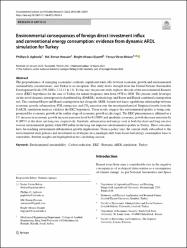Environmental consequences of foreign direct investment infux and conventional energy consumption: evidence from dynamic ARDL simulation for Turkey
Özet
The preponderance of emerging economies confronts signifcant trade-ofs between economic growth and environmental
sustainability considerations, and Turkey is no exception. This study draws strength from the United Nations Sustainable
Development Goals (UN-SDGs-7,11,12 & 13). To this end, the present study explores the role of the environmental Kuznets
curve (EKC) hypothesis for the case of Turkey for annual frequency data from 1970 to 2020. The present study leverages
on the novel dynamic autoregressive-distributed lag (DARDL) methodology and Bayer and Hanck combined cointegration
test. The combined Bayer and Hanck cointegration test alongside ARDL bounds test traces equilibrium relationship between
economic growth, urbanization, FDI, energy use, and CO2 emission over the investigated period. Empirical results from the
DARDL simulation analysis validates the EKC hypothesis. These results suggest that environmental quality is being compromised for economic growth at the earlier stage of economic growth (scale stage). The EKC phenomenon is afrmed as a
1% increase in economic growth increase emission level by 0.1580% and quadratic economic growth decrease emission by
0.1095% in the short and long run, respectively. Similarly, urbanization and energy used in both the short and long run also
worsen environmental quality while FDI infux in the long run improves environmental quality in Turkey. These outcomes
have far-reaching environment-urbanization growth implications. From a policy lens, the current study subscribed to the
environmental stick policies and investment on strategies on a paradigm shift from fossil-fuel energy consumption base to
renewables. Further insights are highlighted in the concluding section.
Cilt
29Sayı
35Bağlantı
https://hdl.handle.net/11363/5937Koleksiyonlar
Aşağıdaki lisans dosyası bu öğe ile ilişkilidir:


















